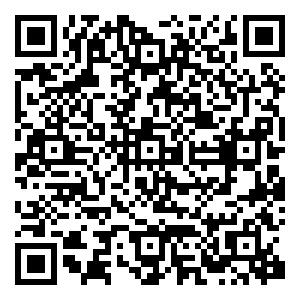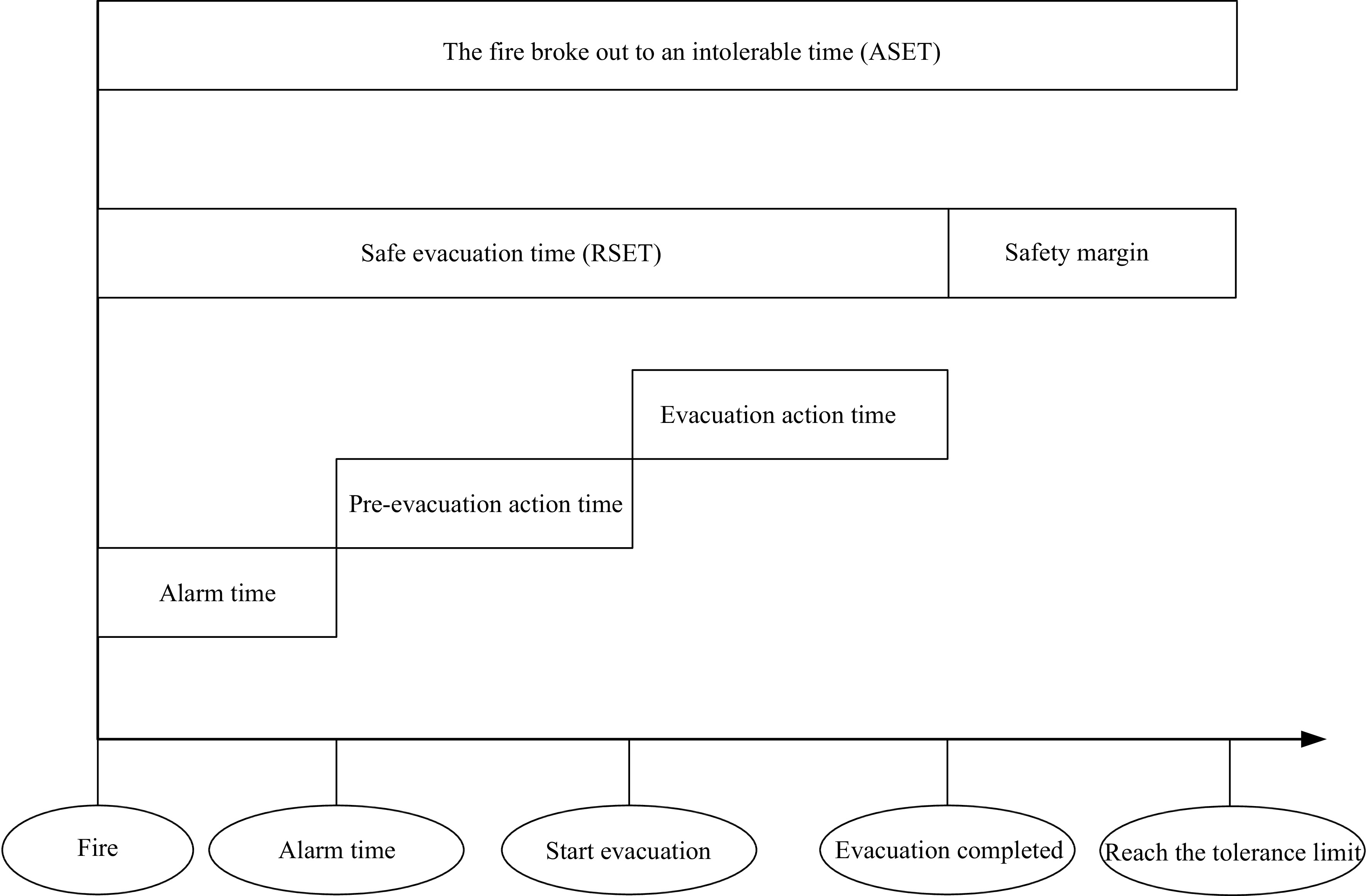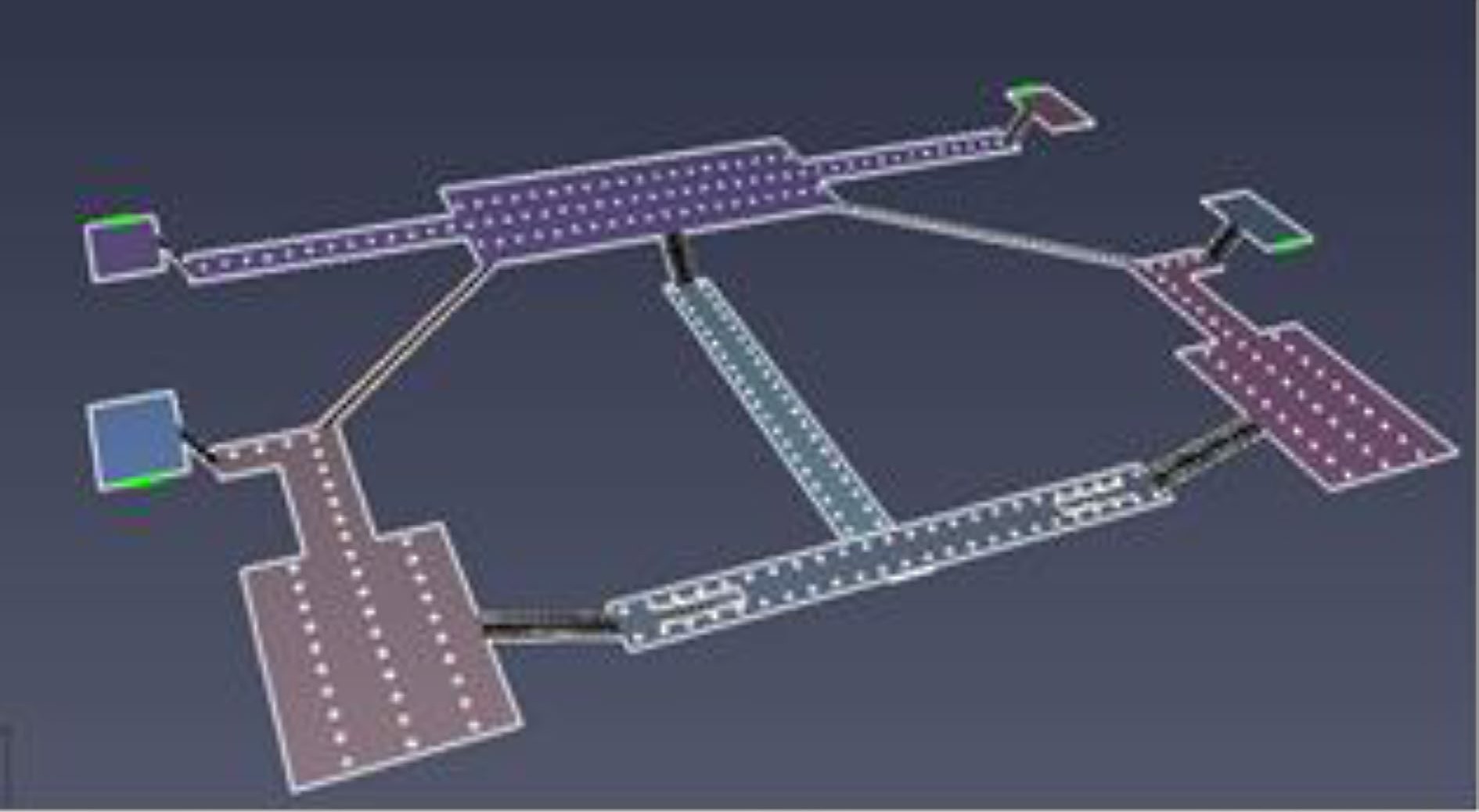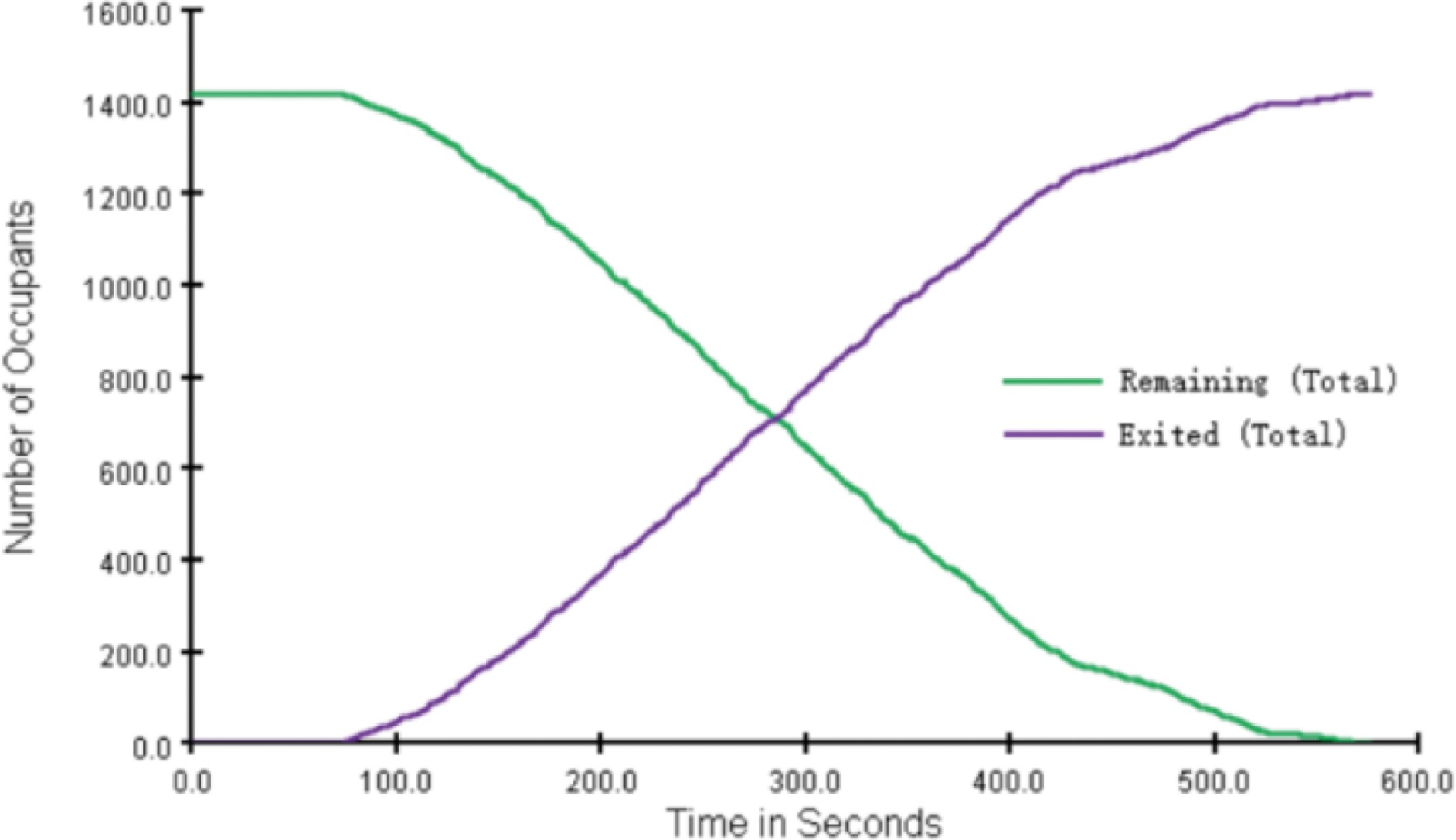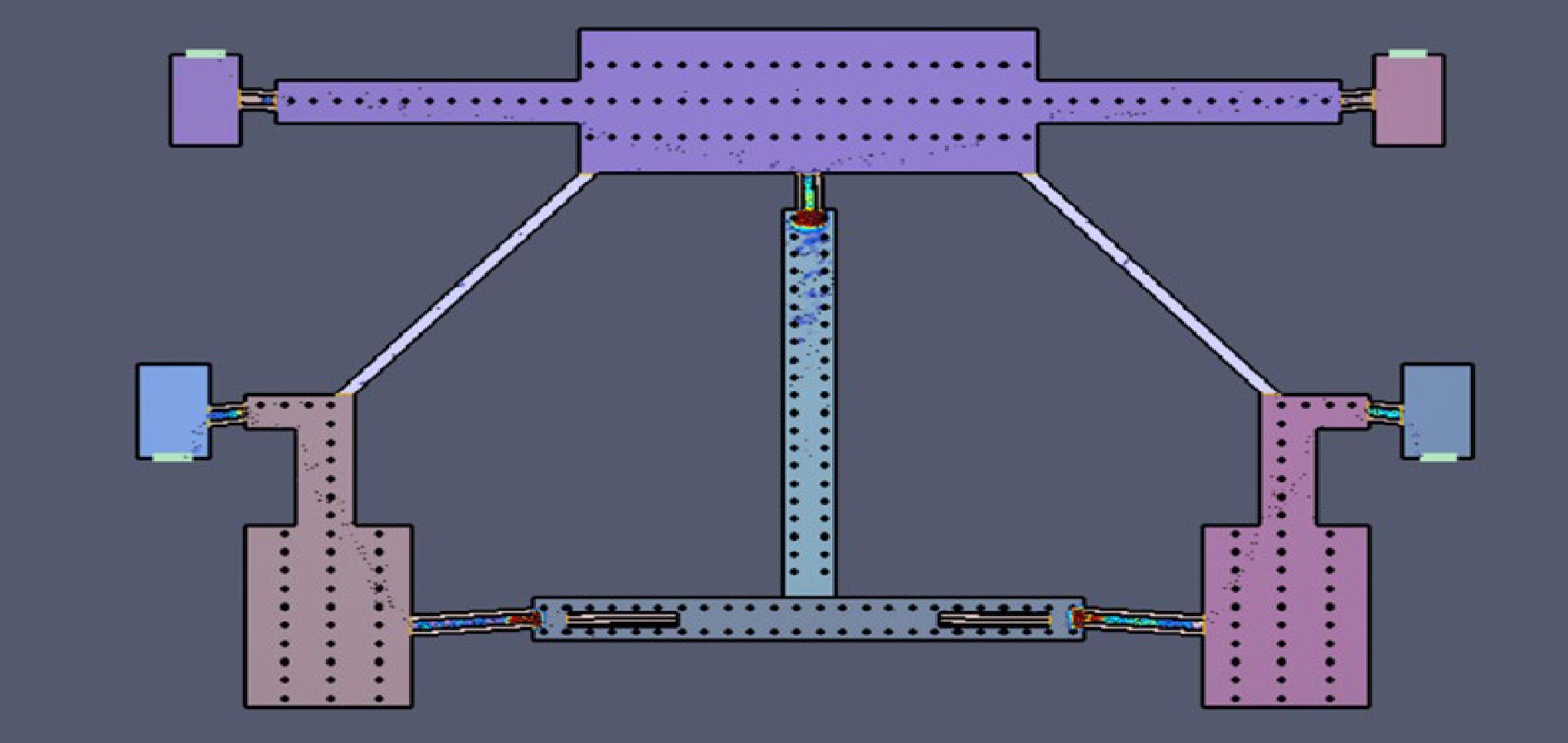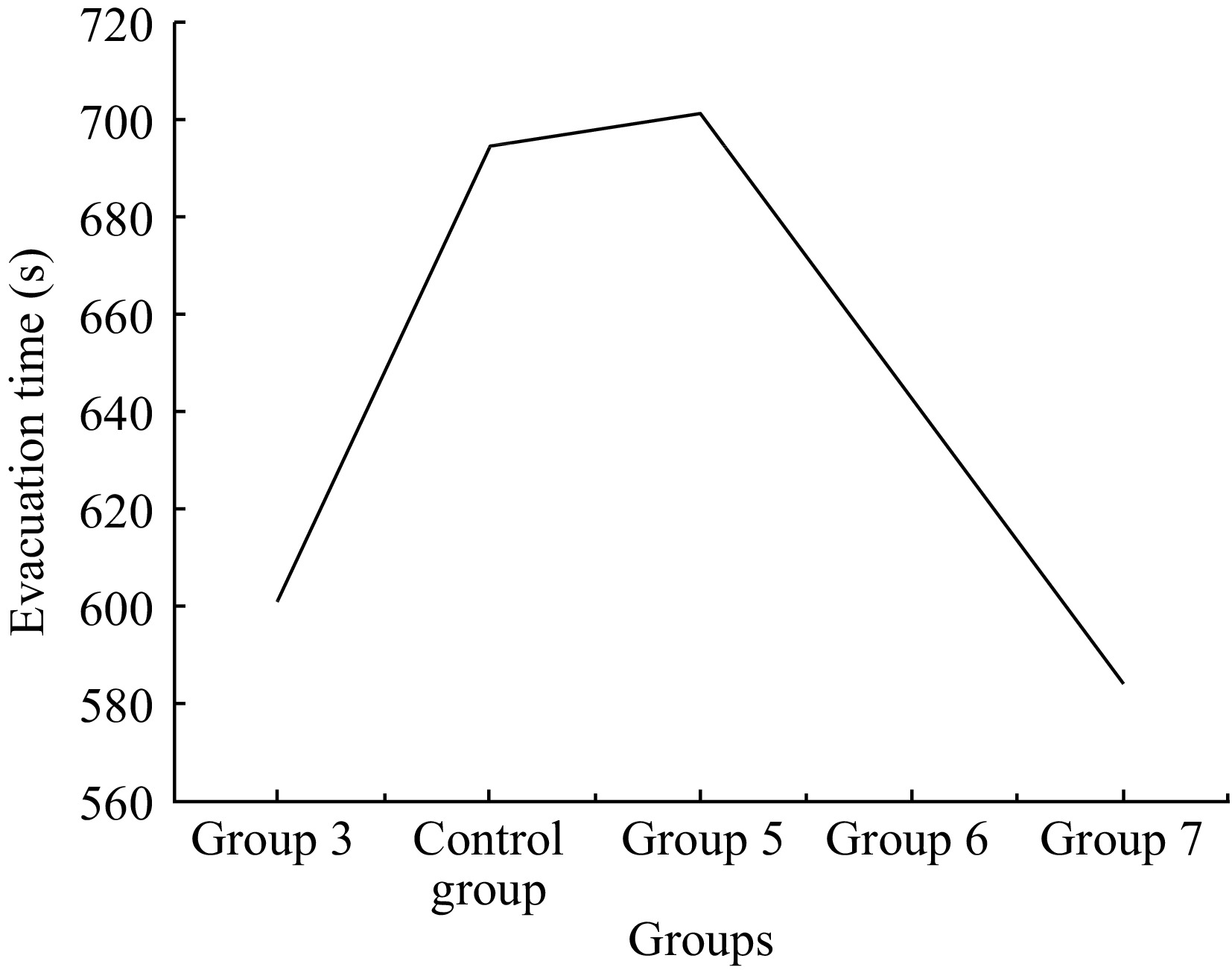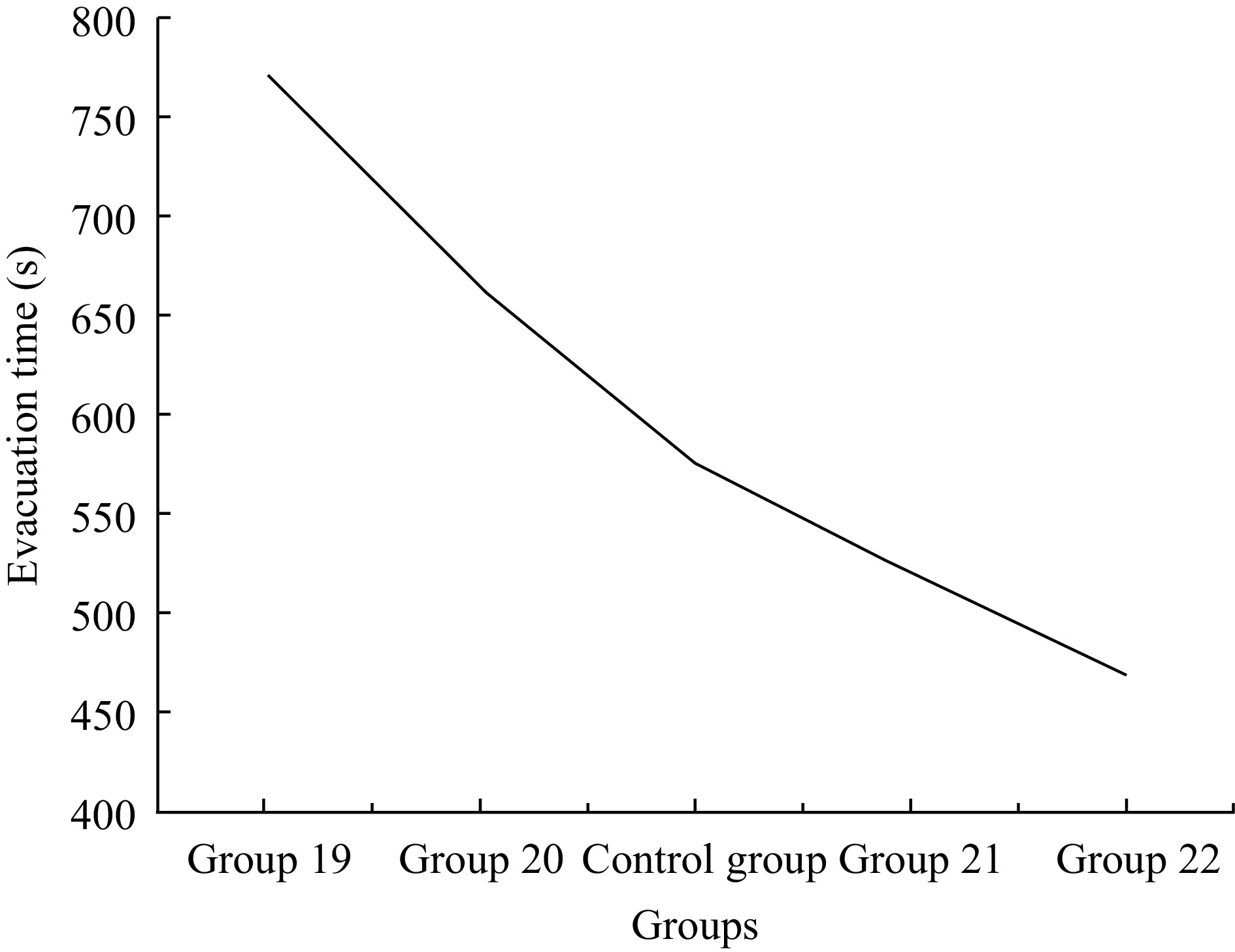-
With the rapid growth of urban populations, people are facing increasing traffic pressure, including serious road congestion and frequent traffic accidents. For the comfort and convenience of travel, the subway is gradually chosen by most people because of its large capacity and fast running speed. However, with the popularization and development of subway rail transit, subway passenger flow is increasing, and subway safety accidents are also emerging. Compared with ordinary subway stations, subway transfer stations are generally set on traffic arteries and connect four trains on two subway lines. The station structure is complex and the flow density is large. The number of people to be evacuated is much larger than that of ordinary stations[1]. Once a fire accident occurs, it may cause serious consequences. However, if people in the subway station can be evacuated to a safe area before the subway fire develops to unable to escape, casualties and property losses can be avoided to the greatest extent[2]. Therefore, it is of great significance to carry out this study to improve the evacuation efficiency of subway transfer stations.
According to statistics, subway safety accidents can be summarized as fire, flood, equipment failure, etc. Fire accidents account for the largest proportion, about 32%[3]. There are three main reasons: First, subway fires are sudden, and thus are difficult to predict and prevent. Second, the subway fire area may be in the station, and may also be in the running subway. It is in the bottom of a relatively closed space, and the use of large fire fighting tools is limited in a relatively narrow space, so fire fighting is difficult[4]. Third, the smoke from burning reduces visibility. The toxic gases and heat damage people's bodies, slow down behavior and cause psychological panic[5]. Xie et al.[6] analyzed the critical conditions of fire and the characteristics of personnel evacuation in subway platform fires, and put forward the model of personnel safety evacuation in a subway platform fire. The available time of personnel safety evacuation was obtained by using the fire simulation software SMARTFIRE4.0, it was also obtained by combining the specific fire conditions, and the corresponding solutions were put forward. In order to study the evacuation of people in the peak period of a subway transfer station, Wu et al.[7] used Pathfinder software to explore the evacuation time, evacuation flow and evacuation bottleneck of pedestrians under various working conditions. Tang et al.[8] used Pathfinder software to simulate the two different scales of peak period and full-load trains in 16 fire scenarios. They analyzed the bottleneck of large-scale crowd evacuation in the event of a fire at a subway transfer station and optimized the evacuation path. However, the emergency evacuation of passengers in a subway transfer station under fire is rarely studied.
In this paper, the software Pathfinder is used to build a subway transfer station model, personnel and their movement behavior model. It simulated the evacuation of a subway station under fire conditions, recorded the evacuation time, analyzed the evacuation bottlenecks and evacuation factors. The specific information is distributed as follows. The form of the subway transfer station, the composition of evacuees and the behavior of personnel are analyzed. The pathfinder is used to establish the model of the subway transfer station, the model of personnel and their movement behavior. The bottlenecks of evacuation and the influencing factors of evacuation are next presented. Finally, we summarize and put forward targeted suggestions. We want to take this as a reference for subway safety management and improve the evacuation efficiency of transfer stations.
-
Subway transfer refers to the transfer of passengers from one subway line to another through the connecting passage between two subway platforms without leaving the paid area[9]. The subway transfer station refers to the subway station that has and connects multiple subway lines[10].
Basic forms of subway platforms
-
The existing subway platforms are mainly island platforms and side platforms. The island platform is located between the uplink and downlink lines, where passengers can freely choose the direction of travel. Side platforms are located on both sides of the uplink and downlink lines, where passengers on the platform can only take a one-way train. Figure 1 shows the different forms of subway platforms.
Main forms of subway transfer stations
-
The forms of subway transfer mainly include the same platform transfer, cross transfer, and T-type or L-type transfer[11].
The transfer on the same platform generally adopts the form of double island platforms. Passengers get off from one side of the island platform and get on the other side to transfer to another subway line. Cross transfer means that two subway platforms intersect at right angles in a three-dimensional space, and the intersection is generally the center of the station. According to the different layout of the platform, it can also be divided into island-island transfer, island-side transfer and side-side transfer[12]. The three forms of cross transfer are shown in Fig. 2.
From the plane point of view, T-type transfer is the intersection of the end of one line station and the middle of another line station. L-type transfer is as the end of the station intersects, which can be combined with the station hall and can be directly transferred to the platform[13]. The T-type transfer and L-type transfer schematic diagram is shown in Fig. 3.
Personnel analysis of subway transfer stations
-
The task of subway fire emergency evacuation is to evacuate people to a safe area efficiently. The first thing to study is the personnel composition and corresponding characteristics in the subway transfer station. Due to the dense flow of people in the subway transfer station, the number of passengers is much larger than the number of staff. The evacuation of passengers is the focus of this study, so the subway staff are not considered.
Considering that adult males are strong, they take up a lot of space have large and fast strides, and they walk faster than adult women when evacuated. So the two types of personnel were studied separately. Also taking into account the age factor, the elderly and children walk significantly slower than adults, and limited by physical fitness and experience level, the response to emergencies is relatively slow, so it is difficult for them to respond quickly. Compared with age, gender has less influence on the evacuation behavior of the elderly and children, so gender is no longer distinguished.
In summary, this paper divides the personnel in the subway transfer station into four categories: adult male, adult female, elderly and children[14].
Personnel behavior analysis of subway transfer stations
-
The goal of evacuation is that all passengers in the transfer station successfully arrive at the exit door. In the simulation, each person will be free to choose their escape path and exit. Ideally, each passenger will choose the nearest stairs and exit to escape.
As shown in Fig. 4, evacuation time includes alarm time, pre-evacuation action time (i.e., personnel reaction time) and evacuation action time[15]. In this paper, the fire detection alarm time and personnel reaction time are combined as evacuation reaction delay time.
Due to the use of escalator evacuation, the movement speed of different people varies, which may lead to push and pull trips. At the same time, considering that the width of the existing stairs meets the requirements of fire evacuation, most of the subway stations in the fire emergency evacuation will be unified in switching the power off to the escalators, guide the pedestrians to use the stairs for evacuation, so all passengers evacuate using the stairs.
At the same time, from a psychological point of view, some people will tend to choose a more familiar route for evacuation, that is, choose the entrance to the subway station as an escape exit. At this time, the escape route may not be the fastest and shortest[16].
This article will set the relevant parameters to establish personnel behavior model based on the above personnel behavior analysis.
-
Pathfinder is an intelligent emergency evacuation simulation software that simulates the evacuation path and evacuation time of people escaping in a disaster. In the software, building models can be constructed by drawing rooms, stairs, etc. The human model is established by setting parameters such as gender, shoulder width and walking speed[17]. The personnel behavior model is established by setting the reaction delay time, escape exit selection, etc. After completing the construction of these three types of models, the fire evacuation of people in the building can be simulated by the software. The evacuation time, the passing rate of each stair exit, the density distribution during the evacuation process, etc. can be recorded, and the entire evacuation process can be presented in 3D animation.
This paper uses Pathfinder software to build a subway transfer station model to simulate the emergency evacuation of passengers in the station during a fire and analyze the evacuation bottlenecks. At the same time, the control variable method is used to simulate the evacuation of passengers under different conditions by changing the relevant parameters, so as to study the influencing factors of evacuation time.
Subway station model establishment
-
The subway station simulated in this paper is the transfer station of Line 1 and Line 2, and the transfer mode is a T-type transfer. There are four layers of subway station, from bottom to top are the platform layer of Line 1, the platform layer of Line 2, the station hall layer and the exit layer[18].
The Line 1 and Line 2 platforms are 120 m long, 12 m wide island platform, the layer height is 8 m, the area is 1,440 m2, both sides are connected with two up and down escalators and a two-way stair passage. The stair width is 2.6 m, the escalator width is 1.5 m, and the escalator speed is 0.5 m/s. There is a 10 m long and 6 m wide transfer platform on the west side of Line 1, which directly leads to Line 2 through the escalators on both sides.
The station hall layer is mainly composed of three rectangular platforms and their channels. Line 1 station hall is a single-ended type station hall, and is located on the east side of the platform. It is 100 m long and 40 m wide. The length of the tunnel is 66 m, the width is 12 m and the total area is 5,584 m2. Line 2 station hall is a double-ended type, the north and south halls are not connected to each other. Each station hall is 50 m long and 35.5 m wide, channel area is 548.25 m2. The total area of the two station halls is 4,646.5 m2. The platform of Line 1 and Line 2 is connected by transfer channels on both sides, and the width of the transfer channel is 4.2 m. Each station hall is connected to two escalators and a two-way stair. The specifications of the stairs are consistent with those described above.
The outlet layer is four rectangular platforms with a length of 25 m and a width of 15 m. The area is 1,500 m2. Each exit platform is provided with an 8 m wide exterior door. In addition, there are structural columns with a length of 1 m, width of 1 m and spacing of 5 m in the platform layer and the hall layer[19]. The subway station model is shown in Fig. 5.
Personnel model establishment
Personnel parameter setting
-
In this paper, the passengers in the subway transfer station are divided into four categories: adult male, adult female, elderly and children. According to 'Chinese adult body size GB 10000-88', adult male and adult female shoulder width data are shown in Table 1.
Table 1. Chinese adult shoulder width data
Percentiles 1 5 10 50 90 95 99 Male shoulder width ( mm ) 330 344 351 375 397 403 415 Female shoulder width ( mm ) 304 320 328 351 371 377 387 According to relevant research, the emergency walking speed at the adult male level is 1.35 m/s, and the emergency walking speed at the adult female level is 0.98 m/s[20]. According to the 'subway safety evacuation norms', the movement speed of the elderly and children is 0.76 m/s[21].
Therefore, the personnel model parameters are set. The peak period is generally the commuting period, and the passengers are mainly adults. So adult males, adult females, the elderly and children are set to account for 40%, 40%, 10%, 10% of the total members respectively. The adult male’s shoulder width is 37.5 cm, the movement speed is 1.35 m/s, and the height is 1.8 m. The adult female's shoulder width is 35.1 cm, the movement speed is 0.98 m/s, and the height is 1.7 m. The elderly's shoulder width is 36 cm, the movement speed is 0.76 m/s, and the height is 1.6 m. The children's shoulder width is 30 cm, the movement speed is 0.76 m/s, and the height is 1.4 m.
Evacuation population setting
-
The people to be evacuated include four categories: passengers on the train, passengers waiting on the platform, passengers in the station hall and passengers in the transfer corridor.
The subways of Line 1 and Line 2 simulated in this paper each contain four carriages, each carriage has a capacity of 100 people, and the number of people on a train is 400. There are 100 passengers waiting at each of the two platforms. There are 100 passengers in each of the three stations. The number of people on the left and right transfer channels and transfer platforms is 120, and the total number of evacuations is 1,420.
Personnel behavior model establishment
-
According to relevant research, the sum of fire detection alarm time and personnel response time in subway stations is generally 30−60 s[22−24]. Therefore, the response delay of adult males and adult females was set to a normal distribution with an average of 45 s, a maximum of 60 s, and a minimum of 30 s. Due to physical fitness and life experience, the reaction speed and movement speed of the elderly and children are slow. So we set them all to the most dangerous situation, 60 s.
As described above, all passengers are set to use only stairs for evacuation and all escalators are out of service.
At the same time, considering the psychological factors of the personnel, the passengers on the platform, in the station hall and in the transfer channel are set to enter the subway station from any exit. The number of passengers entering each exit is the same, accounting for 25% of the total number. Among the number of people entering each export, 30% choose the original export to escape, and 70% choose any export to escape. The passengers on and off the two trains chose any exit to escape. We choose any exit escape is equivalent to choosing the nearest escape exit.
-
When a fire breaks out in this subway station, the changing curves of the number of people evacuated to the safety exit and stranded in the subway station are shown in Fig. 6. It can be seen from the figure that after the delay time of personnel response, the first passenger evacuated successfully at 70 s, and the last passenger evacuated successfully at 575.53 s. Therefore, the time required to evacuate all 1420 passengers to the safe area was 575.53 s.
Evacuation bottleneck analysis
-
From the distribution of crowd density in the early stage of evacuation in Fig. 7, it can be seen that due to the large number of people on the platform layer, when passengers are evacuated from the platform layer to the station hall layer, the crowd density reached 3−4 people/m2 on the stairs on the east side of the platform layer of Line 1 and on both sides of the platform layer of Line 2. There are different degrees of congestion. Among them, the congestion on the Line 1 platform on the east side of the stairs is most serious. Although the left and right transfer channels are also narrow, there is no congestion.
From the distribution of crowd density at the end of evacuation in Fig. 8, it can be seen that when the congestion of stairs on both sides of the platform layer of Line 2 disappears, the crowd reaches the station hall layer of Line 2, and the stairs leading to the exit layer of the north and south halls begin to show congestion. At the same time, the congestion of the stairs on the east side of the platform layer of Line 1 is still serious. Because the passengers are blocked at the stairs of the platform layer, the stairs on both sides of the station hall layer of Line 1 to the exit layer are not congested. It can be seen that the evacuation bottleneck of the subway transfer station is the stair entrance, especially the stairs on the east side of the platform layer of Line 1. Therefore, special attention should be paid to the use of stairs to alleviate congestion and improve the pass rate to shorten the evacuation time.
Evacuation time influence factor experiment
The use of escalators
-
According to the 'Subway Design Fire Protection Standard' 6.2.1, escalators can be used for evacuation when they meet the corresponding fire protection standards and can operate normally under accident conditions[25]. In order to study the influence of the use of escalators on evacuation time, this paper set up group 1. It is set that all stairs and escalators can be used during evacuation, and passengers choose to use stairs or escalators independently.
Evacuation time obtained in the experiment is shown in Table 2. The evacuation time of group 1 is 569.2 s, which is improved compared with 575.53 s of the control group using only stairs. So the use of escalators is beneficial to shorten the evacuation time.
Table 2. Experimental results of using escalators.
Group Escalator used or not Evacuation time (s) Group 1 Yes 569.2 Control group No 575.53 Escalator speed
-
Considering that most of the escalators on the market are at speeds of 0.5 m/s and 0.65 m/s, in order to study the influence of escalator speed on evacuation time, group 1 was selected as the control group, and the escalator speed was 0.5 m/s , as described above. The escalator speed in group 2 was 0.65 m/s.
The experimental evacuation time is shown in Table 3. The evacuation time of group 2 is 562.2 s. When the escalator speed increased to 0.15 m/s, the evacuation time shortened by 7 s. With the increase of escalator speed, the evacuation time is shortened accordingly. Therefore, to ensure evacuation safety, escalators should be developed specifically for evacuation. Subway stations can choose to install a faster escalator when funds allows.
Table 3. Experimental results of using escalators.
Group Escalator speed (m/s) Evacuation time (s) Group 2 0.65 562.2 Control group 0.5 569.2 In subway construction, it should be considered that escalators are also used for evacuation. The fire prevention measures of escalators should be emphasized to ensure their normal operation in accidents and improve their reliability in fires.
Preference for stairs and escalators
-
On the basis of the use of escalators, taking into account the different preferences of each person for escalators and stairs, the personnel behavior is divided into stairmen, escalator standers and escalator walkers. The stairmen only choose stairs, not escalators. Escalator standers only choose the escalator and remain stationary on the escalator at the speed of the escalator. Escalator walkers only choose the escalator and walk on the escalator. The speed of the escalator walkers is the speed of the escalator plus its own speed. We set the priority of stairmen and escalator standers to 0, and escalator walkers to 1, that is, escalator standers will make way for escalator walkers.
In order to explore the influence of the use of stairs and escalators on evacuation time, this paper set up nine groups of experiments by changing the proportion of stairs and escalators.
Firstly, in the case of the same proportion of escalator walkers and escalator standers, the proportion of stairmen was set to 20% in group 3, 30% in group 4, 40% in group 5, 50% in group 6 and 60% in group 7. The proportion of escalator walkers and escalator standers were 40% and 40%, 35% and 35%, 30% and 30%, 25% and 25%, and 20% and 20%, respectively.
The evacuation time obtained from the experiment is shown in Table 4 and Fig. 9. The evacuation time in group 3, group 4, group 5, group 6 and group 7 are 601.3 s, 694.5 s, 701.1 s, 641.5 s and 584.6 s, respectively. When the proportion of stairmen is less than 40%, the evacuation time decreases with the decrease of the proportion of stairmen, for every 10% decrease in the proportion, the evacuation time is shortened by 49.9 s on average. When the proportion of stairmen is more than 40%, the evacuation time decreases with the increase of the proportion of stairmen, for every 10% increase in the proportion, the evacuation time is shortened by 58.25 s on average. When the proportion of stairmen is just 40%, the evacuation time reaches the maximum. This is due to the small proportion of stairmen, although the number of escalator users is rising and congestion may occur, the time consumed by congestion is less than the evacuation time saved by stairmen. When the proportion of stairmen is large, although the evacuation time required for stairmen increases, the number of people using escalators decreases, and the time saved is greater than the increased time for stairmen. When the proportion of stairmen is 40%, the evacuation time required for people using stairs and escalators is larger, so there is a peak.
Table 4. Experimental results of preference for stairs and escalators.
Group Stairmen (%) Escalator walkers (%) Escalator standers (%) Evacuation time (s) Group 3 20 40 40 601.3 Control group 30 35 35 694.5 Group 5 40 30 30 701.1 Group 6 50 25 25 641.5 Group 7 60 20 20 584.6 Next, 20% of the stairmen were selected as the control group. When the proportion of stairmen remain unchanged, the proportion of escalator walkers and escalator standers was set to 30% and 50% in group 8, 50% and 30% in group 9, 60% and 20% in group 10, and 70% and 10% in group 11. The proportions of escalator walkers and escalator standers in the control group were 40% and 40% respectively.
The evacuation time obtained from the experiment is shown in Table 5 and Fig. 10. The evacuation time in group 8, group 9, group 10 and group 11 are 610.3, 571.6, 554 and 537.3 s, respectively. When the proportion of stair walkers is constant, as the proportion of escalator walkers increases, the evacuation time is shortened accordingly, for every 10% increase in the proportion of escalator walkers, the evacuation time is shortened by 18.25 s on average. This is because the use of escalators increases the speed of movement of personnel and makes the evacuation faster.
Table 5. Experimental results of preference for stairs and escalators.
Group Stairmen (%) Escalator walkers (%) Escalator standers (%) Evacuation time (s) Group 8 20 30 50 610.3 Control group 20 40 40 601.3 Group 9 20 50 30 571.6 Group 10 20 60 20 554 Group 11 20 70 10 537.3 Considering that the speed of escalator walkers is greater than that of stairmen, if the proportion of escalator walkers can be increased during evacuation, the evacuation time can be greatly shortened. Therefore, people can be called on to choose to walk on the escalator to escape in the form of broadcast during emergency evacuation. At the same time, in order to solve the problem of different walking speeds of people on the escalator, there may also be a problem of dragging and tripping. At the same time, people should be called on not to panic, to let the elderly and children escape in an orderly manner.
Width of stairway
-
In order to explore the influence of stair width on evacuation time, four groups of experiments were set up in this paper. The stair width in group 12, 13, 14, 15 were 1.6, 2.1, 3.1, 3.6 m respectively. The stair width in the control group was 2.6 m as described in 'Subway station model establishment'.
The evacuation time obtained from the experiment is shown in Table 6 and Fig. 11. The evacuation time in group 12, group 13, group 14 and group 15 are 775.7, 644.3, 561.3, and 539.3 s, respectively. With the increase of stair width, the evacuation time is shortened. When the stair width is less than 2.6 m, the average evacuation time increases by 100.085 s when the stair width is shortened by 0.5 m. When the width of stairs is greater than 2.6 m, the evacuation time decreases by 36.23 s for every 0.5 m increase in the width of stairs. It can be seen that with the increase of stair width, the decrease of evacuation time becomes smaller. This is because when the stairs reach a certain width, the evacuation requirements have been met, and the congestion is not serious. Therefore, the increase in the width of the stairs will not significantly shorten the evacuation time. Subway construction should pay attention to the setting of stair width, if the funds allow, the width should be as large as possible.
Table 6. Experimental results of stair width.
Group Stair width (m) Evacuation time (s) Group 12 1.6 775.7 Group 13 2.1 644.3 Control group 2.6 575.53 Group 14 3.1 561.3 Group 15 3.6 539.3 Exit familiarity
-
Taking into account the psychological factors of the occupants during evacuation, passengers may choose their more familiar exit (i.e., the entrance used to enter the subway station ) to escape. In order to study the effect of this behavior on evacuation time, three groups of experiments were set up by changing the proportion of people with this behavior, which were 10% in group 16, 20% in group 17 and 40% in group 18. The control group was 30% as described above.
The evacuation time obtained from the experiment is shown in Table 7 and Fig. 12. The evacuation time in group 16, group 17 and group 18 are 569.7 s, 572.3 s and 578.1 s respectively. As the proportion of passengers using familiar exits increases, the evacuation time increases accordingly. For every 10% increase, the evacuation time is extended by an average of 2.8 s. This is because passengers evacuated from familiar exits do not choose the nearest exit, but choose their own familiar path against the direction of the flow of people. This not only increases the evacuation time individually, but also in the evacuation of other passengers with contact collisions, thus affecting the evacuation of other passengers.
Table 7. Export familiarity experimental results.
Group Familiar with exit evacuation (%) Any exit evacuation (%) Evacuation time (s) Group 16 10 90 569.7 Group 17 20 80 572.3 Control group 30 70 575.53 Group 18 40 60 578.1 According to the exit familiarity experiment, the greater the proportion of people who choose to be familiar with the exit evacuation, the longer the evacuation time. Therefore, the proportion of such personnel should be minimized. It is possible to help passengers quickly find the optimal escape route by setting clear and easy-to-understand guidance signs in subway stations.
Velocity of movement
-
In order to explore the influence of people's movement speed on evacuation time, this paper sets up four groups of experiments by changing the walking speed of all kinds of people. The speed of adult male, adult female, elderly and children were: 1.15, 0.78 and 0.56 m/s respectively in group 19; 1.25, 0.88, and 0.66 m/s in group 20; 1.45, 1.08, and 0.86 m/s in group 21; 1.55, 1.18, and 0.96 m/s in group 22. The speed in the control group was 1.35, 0.98, and 0.76 m/s as described above.
The evacuation time obtained from the experiment is shown in Table 8 and Fig. 13. The evacuation time in group 19, group 20, group 21 and group 22 are 771.6, 663, 519.8, and 468.9 s respectively. The evacuation time decreases with the increase of movement speed, for every 0.1 m/s increase in personnel speed, the evacuation time is shortened by 75.675 s on average. Time is the ratio of distance to speed. As the speed increases, the time is shortened, which conforms to the general law. Therefore, people can be urged to speed up by broadcasting during evacuation. At the same time, we should pay attention to the evacuation of the elderly and children. These groups of people are slow in movement and response, and their physical fitness is poor. They are affected by smoke and smoke in the fire, which is prone to danger and requires longer evacuation time.
Table 8. Experimental results of motion speed.
Group Adult male
(m/s)Adult female
(m/s)Elderly and children
(m/s)Evacuation time
(s)Group 19 1.15 0.78 0.56 771.6 Group 20 1.25 0.88 0.66 663 Control group 1.35 0.98 0.76 575.53 Group 21 1.45 1.08 0.86 519.8 Group 22 1.55 1.18 0.96 468.9 -
In this paper, Pathfinder simulation is used to construct a subway transfer station model with subway stations of Line 1 and Line 2 and with a T-type transfer mode. The bottlenecks of fire evacuation and the influencing factors of evacuation time in subway transfer station are researched. The following conclusions are obtained:
1 ) The bottlenecks of subway transfer station fire emergency evacuation is the stair entrance. Therefore, we should pay special attention to the use of stairs, effectively alleviate the congestion phenomenon, improve the pass rate, so as to shorten the evacuation time. Under the premise that the funds allow and ensures that the personnel are relatively stable on the escalator, the escalator with a faster speed can be selected to evacuate the personnel at the same time as the stairs.
2 ) When the proportion of stairmen is less than 40%, the evacuation time decreases with the decrease of the proportion of stairmen. When the proportion of stairmen is more than 40%, the evacuation time decreases with the increase of the proportion of stairmen. As the proportion of escalator walkers increases, the evacuation time is shortened.
3 ) The increase in the proportion of familiar exit personnel evacuation will increase the evacuation time. According to the movement speed experiment, with the increase of the movement speed of the personnel, the evacuation time is significantly shortened. For every 0.1 m/s increase in the speed of the personnel, the evacuation time is shortened by 75.675 s on average.
4 ) With the increase of stair width, the evacuation time is shortened accordingly. The decrease of evacuation time decreases with the increase of stair width. Therefore, subway construction should pay attention to the setting of stair width, and the width should be as large as possible when the funds allows.
There are also some limitations in this work. The work is based on the study of the impact of a certain factor on the evacuation time under normal conditions, and has not yet studied the coupling effect between different factors. We study the evacuation bottlenecks and evacuation influencing factors of the simulated subway transfer station structure, in order to provide reference for the actual subway transfer station fire emergency evacuation. However, there are differences between the simulation structure and the actual structure. The conclusions in this work cannot fully reflect the actual situation of evacuation in a subway transfer station fire. If conditions permit, the actual structure model can be introduced into Pathfinder for further research.
The authors acknowledge the support of the National Natural Science Foundation of China (52004291,52130409), the Fundamental Research Funds for the Central Universities (2022XJAQ02), and the Innovation Training Program for College Students of CUMTB(202212019).
-
Kai Wang is the Editorial Board member of Journal Emergency Management Science and Technology. He was blinded from reviewing or making decisions on the manuscript. The article was subject to the journal's standard procedures, with peer-review handled independently of these Editorial Board members and their research groups.
- Copyright: © 2022 by the author(s). Published by Maximum Academic Press on behalf of Nanjing Tech University. This article is an open access article distributed under Creative Commons Attribution License (CC BY 4.0), visit https://creativecommons.org/licenses/by/4.0/.
-
About this article
Cite this article
Du F, Zhang Q, Wang K, Cui W, Guo Y, et al. 2022. Study on crowd evacuation in subway transfer station fires based on numerical simulation. Emergency Management Science and Technology 2:16 doi: 10.48130/EMST-2022-0016
Study on crowd evacuation in subway transfer station fires based on numerical simulation
- Received: 23 October 2022
- Accepted: 22 December 2022
- Published online: 30 December 2022
Abstract: In order to study the influencing factors of fire evacuation bottlenecks and evacuation time in subway transfer stations, a subway transfer station model was built using Pathfinder to simulate the emergency evacuation of passengers in a fire. Using the control variable method, the evacuation under different conditions is simulated by changing the parameters. The effects of the use of escalators, the speed of escalators, preference for stairs and escalators, the use of escalators, the familiarity of exits, the speed of personnel movement and the width of stairs on evacuation time are discussed and analyzed. The results show that the fire evacuation bottlenecks of subway transfer stations is each stair entrance. Evacuation time can be shortened by increasing the speed of escalators, increasing the proportion of escalator walkers, reducing the proportion of passengers who choose familiar exits to escape, increasing the speed of passengers and increasing the width of stairs.
-
Key words:
- Front Matter /
- Crowd /
- Evacuations /
- Subways /
- Transfer /
- Station








